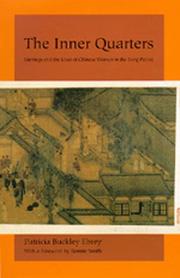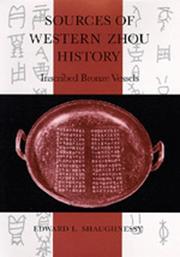| Listing 1 - 2 of 2 |
Sort by
|

ISBN: 0520913485 0585104344 9780520913486 9780585104348 9780520081567 9780520081581 0520081560 0520081587 Year: 1993 Publisher: Berkeley, CA : University of California Press,
Abstract | Keywords | Export | Availability | Bookmark
 Loading...
Loading...Choose an application
- Reference Manager
- EndNote
- RefWorks (Direct export to RefWorks)
The Sung Dynasty (960-1279) was a paradoxical era for Chinese women. This was a time when footbinding spread, and Confucian scholars began to insist that it was better for a widow to starve than to remarry. Yet there were also improvements in women's status in marriage and property rights. In this thoroughly original work, one of the most respected scholars of premodern China brings to life what it was like to be a woman in Sung times, from having a marriage arranged, serving parents-in-law, rearing children, and coping with concubines, to deciding what to do if widowed. Focusing on marriage, Patricia Buckley Ebrey views family life from the perspective of women. She argues that the ideas, attitudes, and practices that constituted marriage shaped women's lives, providing the context in which they could interpret the opportunities open to them, negotiate their relationships with others, and accommodate or resist those around them. Ebrey questions whether women's situations actually deteriorated in the Sung, linking their experiences to widespread social, political, economic, and cultural changes of this period. She draws from advice books, biographies, government documents, and medical treatises to show that although the family continued to be patrilineal and patriarchal, women found ways to exert their power and authority. No other book explores the history of women in pre-twentieth-century China with such energy and depth.
Marriage --- Women --- Sociology & Social History --- Social Sciences --- Family & Marriage --- History. --- Social conditions. --- History --- Social conditions --- China --- History of Asia --- anno 900-999 --- anno 1000-1099 --- anno 1100-1199 --- anno 1200-1299 --- 20th century. --- academic. --- advice. --- arranged marriage. --- biography. --- chinese dynasty. --- chinese women. --- concubines. --- culture. --- dynastic. --- economics. --- feminism. --- feminist. --- footbinding. --- gender studies. --- government. --- marriage. --- medical. --- patriarchal. --- patriarchy. --- politics. --- premodern china. --- property rights. --- raising children. --- relationships. --- scholarly. --- sung dynasty. --- true story. --- widow. --- women in china. --- womens issues. --- womens rights. --- womens studies. --- world history.

ISBN: 0520910222 1282355716 9786612355714 0585159378 9780520910225 9780585159379 0520070283 9780520070288 Year: 1991 Publisher: Berkeley University of California Press
Abstract | Keywords | Export | Availability | Bookmark
 Loading...
Loading...Choose an application
- Reference Manager
- EndNote
- RefWorks (Direct export to RefWorks)
The thousands of ritual bronze vessels discovered by China's archaeologists serve as the major documentary source for the Western Zhou dynasty (1045-771 B.C.). These vessels contain long inscriptions full of detail on subjects as diverse as the military history of the period, the bureaucratic structure of the royal court, and lawsuits among the gentry. Moreover, being cast in bronze, the inscriptions preserve exactly the contemporary script and language.Shaughnessy has written a meticulous and detailed work on the historiography and interpretation of these objects. By demonstrating how the inscriptions are read and interpreted, Shaughnessy makes accessible in English some of the most important evidence about life in ancient China.
Steelhead (Fish) --- Salmon fisheries --- Fisheries --- Anadromous rainbow trout --- Oncorhynchus mykiss --- Sea-run rainbow trout --- Steelhead trout --- Oncorhynchus --- Rainbow trout --- S04/0500 --- S04/0200 --- S17/0900 --- S15/0311 --- Inscriptions, Chinese --- Bronzes, Chinese --- -#SML: Paul Serruys --- Chinese inscriptions --- Chinese bronzes --- China: History--Ancient (Pre-Han and Han, incl. Sima Qian) --- China: History--Historiography and theory of history --- China: Art and archaeology--Bronzes: general (incl. Ordos and Northern frontiers) --- China: Language--Bronze inscriptions: general 金文 --- China --- Cina --- Kinë --- Cathay --- Chinese National Government --- Chung-kuo kuo min cheng fu --- Republic of China (1912-1949) --- Kuo min cheng fu (China : 1912-1949) --- Chung-hua min kuo (1912-1949) --- Kina (China) --- National Government (1912-1949) --- China (Republic : 1912-1949) --- People's Republic of China --- Chinese People's Republic --- Chung-hua jen min kung ho kuo --- Central People's Government of Communist China --- Chung yang jen min cheng fu --- Chung-hua chung yang jen min kung ho kuo --- Central Government of the People's Republic of China --- Zhonghua Renmin Gongheguo --- Zhong hua ren min gong he guo --- Kitaĭskai︠a︡ Narodnai︠a︡ Respublika --- Činská lidová republika --- RRT --- Republik Rakjat Tiongkok --- KNR --- Kytaĭsʹka Narodna Respublika --- Jumhūriyat al-Ṣīn al-Shaʻbīyah --- RRC --- Kitaĭ --- Kínai Népköztársaság --- Chūka Jinmin Kyōwakoku --- Erets Sin --- Sin --- Sāthāranarat Prachāchon Čhīn --- P.R. China --- PR China --- PRC --- P.R.C. --- Chung-kuo --- Zhongguo --- Zhonghuaminguo (1912-1949) --- Zhong guo --- Chine --- République Populaire de Chine --- República Popular China --- Catay --- VR China --- VRChina --- 中國 --- 中国 --- 中华人民共和国 --- Jhongguó --- Bu̇gu̇de Nayiramdaxu Dundadu Arad Ulus --- Bu̇gu̇de Nayiramdaqu Dumdadu Arad Ulus --- Bu̇gd Naĭramdakh Dundad Ard Uls --- BNKhAU --- БНХАУ --- Khi︠a︡tad --- Kitad --- Dumdadu Ulus --- Dumdad Uls --- Думдад Улс --- Kitajska --- China (Republic : 1949- ) --- History --- -Sources. --- Inscriptions, Chinese. --- Sources --- Sources. --- ancient china. --- antiquity. --- archaeology. --- aristocracy. --- asia. --- authenticity. --- bronze inscription. --- bronze. --- china. --- chinese bronzes. --- chinese history. --- chinese language. --- chinese zhou dynasty. --- chou dynasty. --- dating. --- duke of zhou. --- historiography. --- history. --- law. --- military history. --- military. --- nonfiction. --- orthography. --- premodern china. --- royal court. --- shi qiang pan. --- vessels. --- western zhou. --- zhou dynast. --- -China
| Listing 1 - 2 of 2 |
Sort by
|

 Search
Search Feedback
Feedback About UniCat
About UniCat  Help
Help News
News